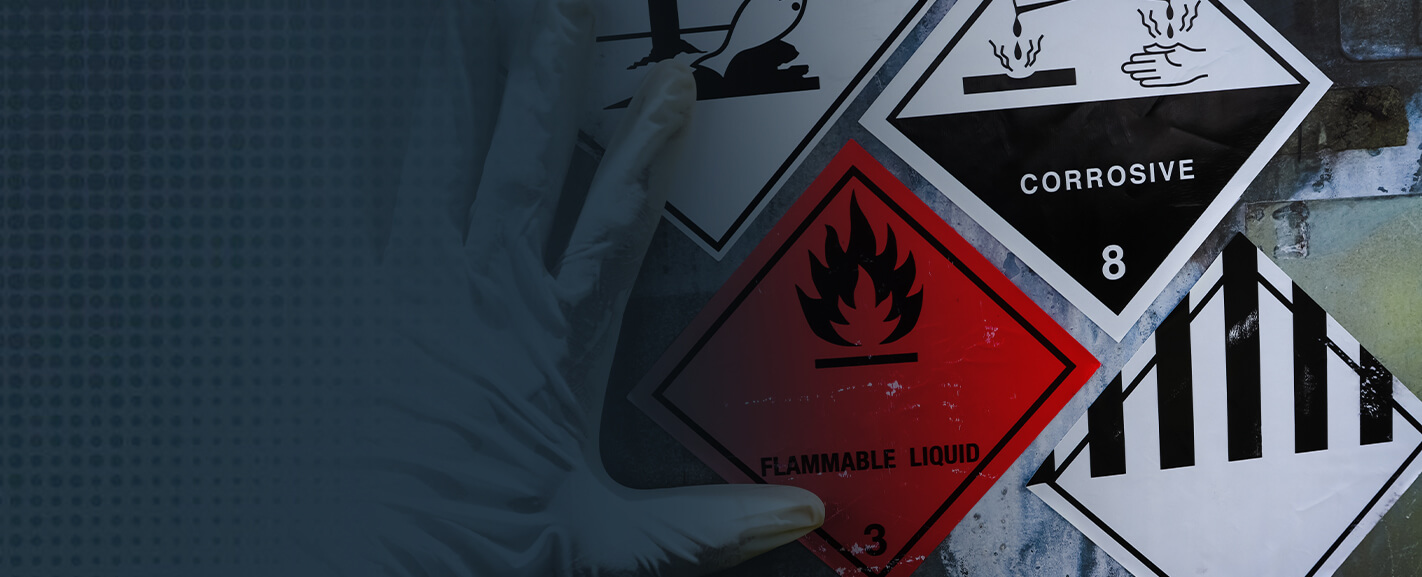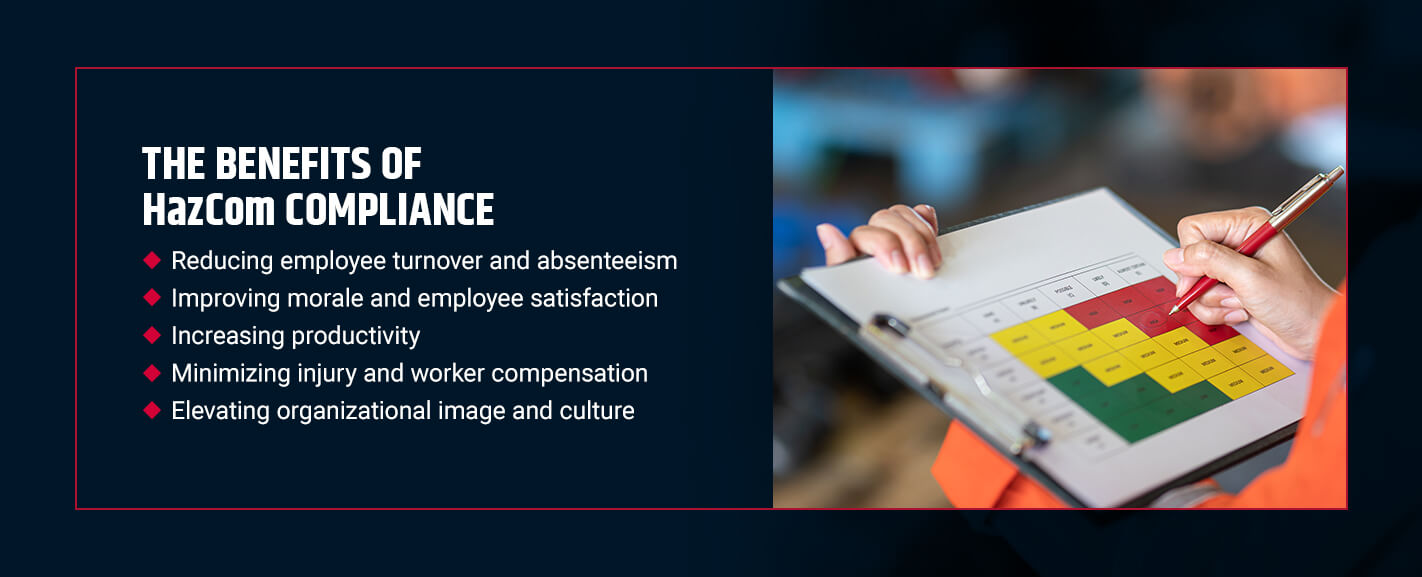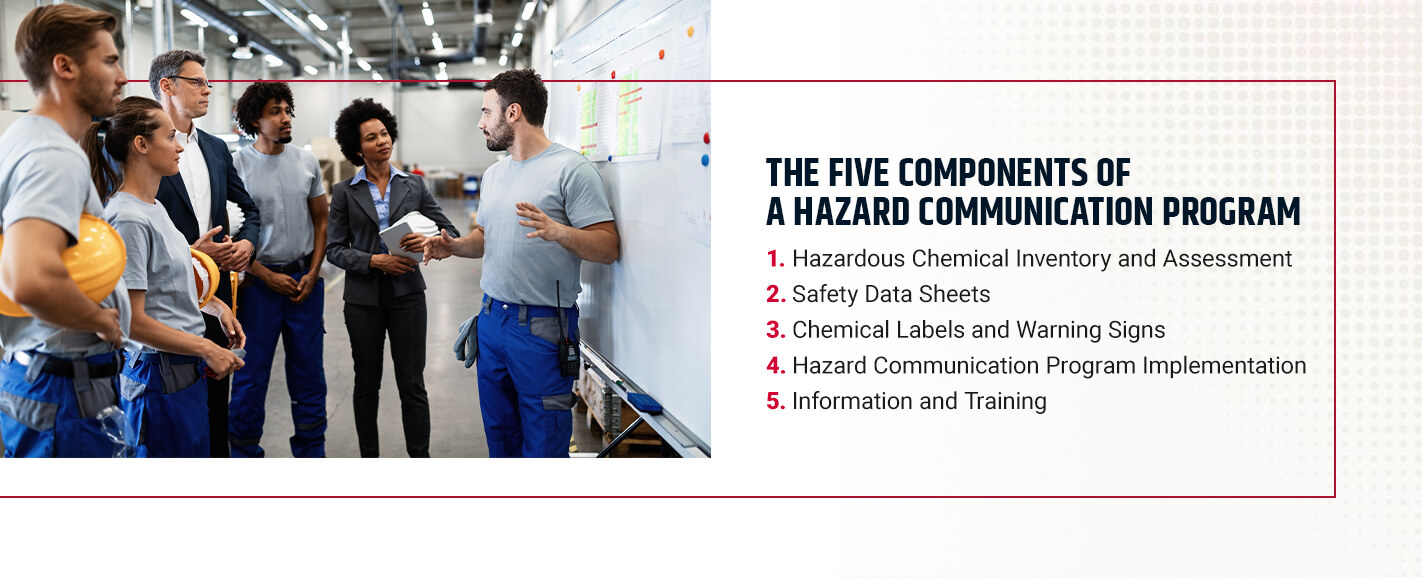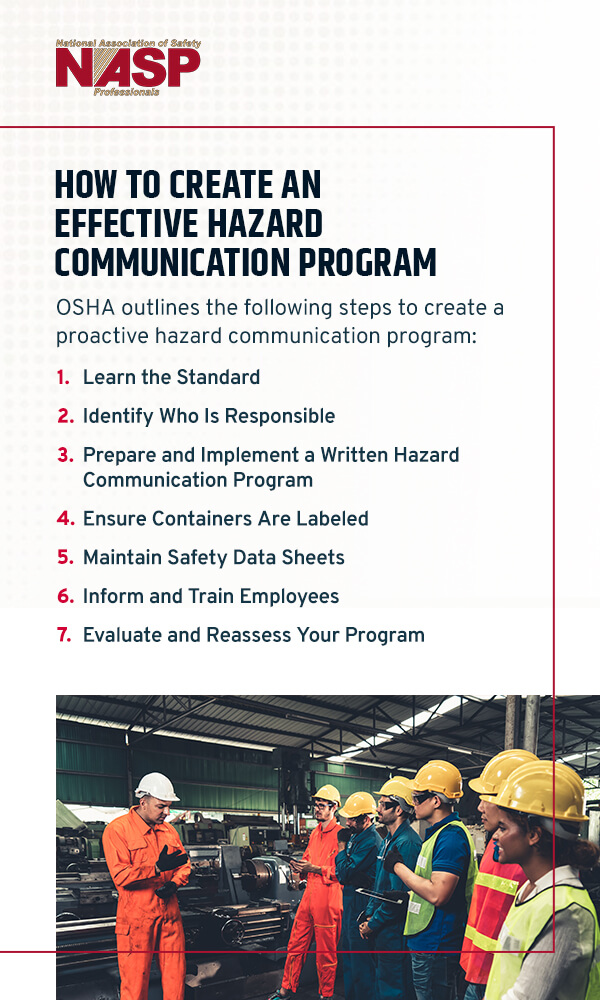
Hazard communication — also known as HazCom — was the second-most-cited OSHA violation in 2022. The Occupational Safety and Health Administration (OSHA) takes HazCom requirements seriously to mitigate the severe risks associated with working alongside workplace chemicals.
OSHA hazard communication requirements for compliance are designed to protect people from any illness or injury that could arise from being exposed to hazardous chemicals in the workplace. HazCom requirements are based on the premise that workers have the right to know what they are working with. Failure to provide this information could result in citations or placement in OSHA’s severe violator enforcement program.
The HazCom requirements are exhaustive and can be challenging to manage. Breaking them down into digestible chunks is the first step to compliance success.
What Is HazCom?
HazCom is critical to safety in the workplace. OSHA manages the HazCom requirements and standards to improve worker safety. Workers have a right to know what chemicals they’re exposed to so they can take the appropriate safety measures.
Workers interacting with chemicals deal with many health hazards, from skin irritation to nausea and vomiting. Businesses meeting OSHA’s hazard communication requirements can promote safety by empowering workers with clear and concise information and detailed training in chemical handling and exposure protocols.
OSHA’s Hazard Communication Standard (HCS) covers labels and communication around hazardous chemicals in the workplace. In 2012, OSHA updated the HCS to integrate with international standards. This Globally Harmonized System (GHS) provided a consistent method of communicating hazards and emphasizing worker understanding.
Why Meeting OSHA HazCom Requirements for Compliance Is Important
OSHA requirements for hazard communication exist to promote worker safety. Workers can confidently perform their jobs when they have information to keep them safe from the chemicals they interact with. Ensuring you meet OSHA hazard communication requirements for compliance can reduce — or even eliminate — injuries, illnesses, health issues, and death resulting from unsafe working conditions.
In addition, workplace health and safety are compulsory. Failure to meet OSHA requirements has significant consequences, including citations and fines over $150,000, depending on the infraction. Violations come in several forms, including improper employee training in hazard communication.

The Benefits of HazCom Compliance
Meeting the requirements for HazCom has significant benefits for your organization, including the following:
- Reducing employee turnover and absenteeism: Communicating hazards according to OSHA regulations results in safer, more confident employees who are willing to work and stay with an organization that prioritizes their well-being.
- Improving morale and employee satisfaction: Addressing health and safety concerns and communicating protocols to workers makes employees happier and more satisfied in their environment.
- Increasing productivity: A safer environment means employees can focus on their core competencies, resulting in a more productive and efficient workforce.
- Minimizing injury and worker compensation: Injury or illness related to poor hazard communication can be costly to your business. You may have to pay worker compensation and OSHA fines, so keeping the workplace safe can save you money.
- Elevating organizational image and culture: An organization compliant with HazCom requirements has an improved reputation among employees and stakeholders. Consistent compliance results in a robust safety culture, increasing your ability to attract and retain quality staff.
The Three Main OSHA Requirements for HazCom
OSHA HazCom requirements are exhaustive, but there are three core elements to remember:
- Hazard classification: All chemicals must undergo standardized laboratory testing. The results are documented, so safety professionals can easily see where to store a chemical and the dangers.
- Detailed description: All hazardous chemicals and the protocols for handling them must be recorded in a standardized safety data sheet (SDS).
- User information: All chemical containers should be labeled with standardized and detailed information on their dangers.

The Five Components of a Hazard Communication Program
The above elements provide a simplistic overview of OSHA HazCom requirements. To meet OSHA standards, safety professionals must delve deeper into the process. The OSHA HazCom standard outlines five critical elements for employers and safety professionals to follow.
1. Hazardous Chemical Inventory and Assessment
Safety professionals must take a complete inventory of all workplace chemicals, from cleaning to processing. Compile written records of each chemical and ensure an SDS for each one. Your inventory should be fluid and available. You can update it regularly as you add, change, and remove chemicals from the area.
2. Safety Data Sheets
A safety data sheet for each chemical is vital to hazard communication compliance. Each SDS comprises a detailed description of each chemical and its associated hazards. The information in an SDS allows you to create protection measures specific to your workplace.
An SDS should contain the name of the chemical and any of its “common” names, a listing of the components, a statement of ingredients known to be carcinogens or cause any other health hazards, and any known dangers associated with the substance.
As per the GHS, the information on your SDS is standardized and should appear in the following order:
- Identification
- Hazard designation
- Composition and specifics of ingredients
- First-aid procedures
- Firefighting procedures
- Accidental release procedures
- Handling and storage
- Exposure controls and personal protection
- Physical and chemical descriptors
- Stability and reactivity
- Toxicological details
- Ecological details
- Disposal considerations
- Transportation information
- Regulatory information
- Additional information, if necessary
Employers and safety managers a required to give workers complete access to safety data sheets so they don’t need to request permission to access the information. You can print them in a binder or keep electronic copies in a shared drive accessible to all employees.
3. Chemical Labels and Warning Signs
While chemical manufacturers and distributors are responsible for correctly labeling items, it falls to the employer or safety manager at a specific location to ensure they are correctly labeled. That secondary container must show the same precise information if the chemical is transferred to another container for holding or mixing.
OSHA recommends that employers or safety managers use pictograms to show clear warnings about the dangers of hazardous chemicals. There are nine pictograms for a visual representation of hazards, including the following:
- Health hazard: Warns of carcinogens, mutagenicity, reproductive, target organ and aspiration toxicity, and respiratory sensitization.
- Flame: Warns of flammable, pyrophoric, self-heating chemicals, combustible gas, self-reactive chemicals, and organic peroxides.
- Exclamation mark: Warns of skin and eye irritations, acute toxicity, narcotic effects, respiratory tract irritations, and hazardous to the ozone layer. The last item is optional.
- Gas cylinder: Warns of gases under pressure.
- Corrosion: Warns of skin corrosion and burns, eye damage, and chemical corrosion to metals.
- Exploding bomb: Warns of explosives, self-reactives, and organic peroxides.
- Flame over circle: Warns of oxidizers.
- Skull and crossbones: Warns of acute toxicity — fatal and highly toxic chemicals.
- Environment: Warns of aquatic toxicity, which OSHA does not mandate.
Workplace Labeling
There are two principal types of container labels under OSHA HazCom regulations — shipping and workplace use. Any container leaving a chemical manufacturing facility must be labeled with the same format as GHS labels.
OSHA regulations around labeling these chemicals eliminate the challenge of missing or unclear chemical information. Once the chemical reaches the organization, OSHA relaxes the labeling regulations, as different layouts may be more effective for workers. There are still some primary regulations around workplace labeling, including the following:
- Product identifier: The label must show the name of the product.
- Basic hazard information: Basic hazard information must be displayed on the label.
Detailed information about the material, including worker safety protocols, must be available to workers whenever needed, but it does not have to be displayed on the label.
4. Hazard Communication Program Implementation
A written hazard communication program is often one of the primary steps an organization must take to meet OSHA requirements for HazCom. Each safety professional must build and manage a customized program outlining all aspects of the HCS. Your hazard communication program should be accessible for ongoing use.
Implementing a hazard communication program is essential for workplace safety, so it requires more than filing your written plan away somewhere. Instead, the safety management team must continue to provide all workers with accurate and up-to-date information on all health and safety hazards in their workspace and how to protect themselves.
The written hazard communication program better informs and prepares workers to be productive and safe in their workflow. If necessary, a workplace risk assessment consultant can help you pinpoint opportunities for improvement in your current safety management practices.
5. Information and Training
Employees who may be exposed to hazardous chemicals must receive adequate education and training to work with dangerous materials. Worker safety training should cover OSHA’s hazard communication requirements and the internal written communication program detailing any relevant communications on working with hazardous chemicals.
Worker training should also include the following:
- Being more mindful of workplace hazards
- Reading an SDS before working with any dangerous chemicals
- Following protocols when exposed to hazardous materials
- Preventing errors when handling hazardous chemicals that could lead to mislabeling, injuries, spills, and serious chemical-related workplace incidents
- Improving safety communication throughout the organization
Safety managers and business owners should provide safety training to all employees before working with any chemicals. They should also provide training on any new chemicals entering the work area.
OSHA does not specify a format for HazCom training. However, it should be comprehensive and easy for employees to digest.

How to Create an Effective Hazard Communication Program
OSHA outlines the following steps to create a proactive hazard communication program:
1. Learn the Standard
First and foremost, employers and business owners must obtain a copy of OSHA’s HazCom standard and familiarize themselves with the requirements. It’s a comprehensive document detailing all the steps organizations must take to maintain compliance.
2. Identify Who Is Responsible
To have a practical and workable hazard communication program and ensure none of the requirements slip through the cracks, you have to assign the responsibility to an individual. This hazard communication manager must implement a system to ensure your organization meets the relevant requirements. They must also select a team responsible for the activities associated with effective hazard communication, such as training and labeling.
3. Prepare and Implement a Written Hazard Communication Program
Your written hazard communication program must cover all the methods of addressing hazard communication in detail for your organization. One of the purposes of this written program is to ensure systematic compliance with the hazard communication standard.
Your chemical inventory forms part of your written hazard communication program. It must be regularly updated to reflect the chemicals and practices used in your organization.
4. Ensure Containers Are Labeled
With all the potentially harmful chemicals cataloged in your inventory, you can now progress to correctly labeling your containers. Although all the information you need is on the label when you receive the chemicals from the manufacturer, you can choose how to label your containers internally.
Label any secondary containers you use for chemical mixing and storage, as failure is a common OSHA violation.
5. Maintain Safety Data Sheets
Safety data sheets are not static — safety management personnel must update them regularly. OSHA requires you to request SDSs from your supplier if you don’t receive them. The critical purpose of SDSs is that they are available to all employees working with hazardous chemicals. While many safety managers choose to keep hard copies in the workplace, digital versions are becoming more popular and convenient.
If you choose to have a digital copy of your SDS, you must have a backup available in case of a power outage or equipment failure. OSHA also requires you to train your workforce to access the SDSs if you store them in digital format.
6. Inform and Train Employees
As mentioned above, OSHA requires organizations to train their employees in hazard communication. While they grant some freedom in the training techniques, they do require safety personnel to provide employees with the following information:
- OSHA HazCom requirements,
- Information about the presence of hazardous chemicals in any area they work in or that they use during the course of their work, and
- Access to your organization’s written hazard communication program and safety data sheets.
OSHA also has a minimum training requirement for employees. While organizations should provide comprehensive training to employees, OSHA requirements include the following:
- Methods and observations: Employees must know how chemicals in the workplace are monitored, such as whether an employer or safety manager is monitoring the area or if devices are in place to measure the number of chemicals in the immediate atmosphere. They must also be well-versed in the appearance and odor of chemicals they could come into contact with.
- Chemical hazards in the area: Training must provide employees with information on the physical, health, asphyxiation, pyrophoric gas and combustible dust hazards, and any other hazards that may not be classified in the above categories.
- Protective measures: Employers must provide training in their actions to protect themselves from the aforementioned hazards, including the specific procedures — implemented by the employer or safety manager — to protect them from exposure. They must know the work practices the organization has in place, emergency procedures to take in case of exposure and what personal protective equipment (PPE) they should use when handling hazardous chemicals.
- Hazard communication program: Employers must provide training on their organization’s internal hazard communication program, including an explanation of the shipping labels, SDSs, and how they can obtain and use hazard information when needed.
7. Evaluate and Reassess Your Program
Program evaluation is critical to identify improvement opportunities. Consult with staff members and ask them for feedback on areas of your HazCom program that they find challenging and assess any incidents that have occurred. Update your written hazard communication program to reflect any changes and inform your workers so they can view the updates.
Trust The National Association of Safety Professionals to Help You Meet HazCom Training Requirements
The National Association of Safety Professionals provides workplace safety training across various industries. You can earn safety certificates and participate in classroom or online training to ensure you can provide workers with the best possible information. NASP training is built for, and by, safety professionals.
Our Hazard Communication Specialist course ensures you have the skills to make your operations HazCom compliant and that your team can handle hazardous chemicals in the workplace. Whatever your training needs, you can trust NASP to update you with the latest OSHA requirements. Contact us today to learn more about how we can help you implement The Practical Approach to Workplace Safety.






